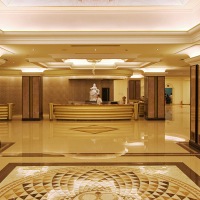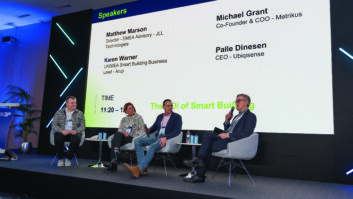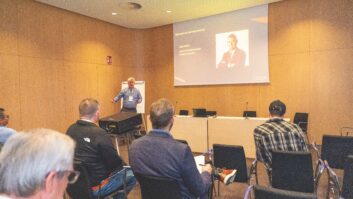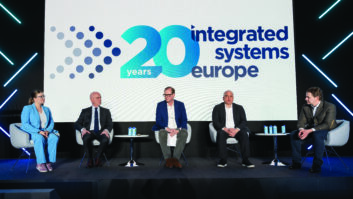
Technology has rapidly been incorporated into all electromechanical devices in all walks of life: from cars and phones to TVs. Building control devices have not escaped this trend; as heating, ventilation and air-conditioning (HVAC) plant , fire and access controllers, lighting and sunshades become ‘intelligent’ and connected. At the same time, audiovisual systems have become more automated and linked to other functions within offices, shops and commercial buildings. How do the two segments interact? Is there a common network or protocol that binds everything together, and how does the AV integrator take advantage of, and interact with, other suppliers and systems?
That there is a demand for integrated building services controlled in a highly efficient manner is beyond doubt. With carbon footprint and energy costs to the fore, building facilities managers are aware of the financial and environmental savings that can be made by fine control of heating, lighting and other services. The savings in energy costs are quantifiable and payback can be measured easily; at the same time, benefits to corporate reputation are large and immeasurable. STEP, the Sustainable Technology Environments Program, is attempting to specifically address the approach to the sustainable planning, design, integration and operation of low-voltage building and communication technologies. However, other rating systems, like the US Green Building Council’s Leadership in Energy and Environmental Design (LEED), and organisations such as the International Code Council (ICC), Green Globes and ASHRAE, do not.
Several providers of building service systems have developed software packages that will help manage a building. One such is leading management consultancy Accenture. Rajesh Sinha, director, smart building and energy-efficiency solutions, explains the company’s involvement: “We have developed tools that can integrate building and energy systems to work order management systems and other applications that can provide detailed analytics and ongoing monitoring and management of building and equipment performance. Through straightforward changes to buildings operation and through the use of smart technologies and analytics, savings of up to 35% are achievable.”
Smart savings
There are deeper benefits and savings to be achieved: “Buildings with smart systems can identify, and often correct, potential issues without human involvement and help on-site staff diagnose problems,” points out Craig Bloomfield, vice president at global real estate services business Jones Lang LaSalle. “With real-time monitoring and control of energy use, air quality and other building functions, systems can adjust to changes in weather, occupancy and equipment conditions, saving energy and extending equipment life as well as making staff more productive. The new generation of automation technology recalibrates building systems on a continuous basis. Today, meters and sensors on equipment provide a wider range of information, analysed by more sophisticated software that uses algorithms to detect when a piece of equipment may not be working at peak performance.”
He continues: “Risk avoidance is a real benefit; the ability to detect and anticipate the potential failure of a device through detection of abnormal operation allows prevention of failure, with the consequential loss to a business. One example is an airline that lost all operations because the power system in its data centre failed, a situation that could have been avoided through smart monitoring.”
There are, as Mark Warburton, sales manager at online consumer electronics retailer Ivoryegg explains, two levels of services: “The workhorse services, like power, heating, lighting and ventilation; and thoroughbreds, including videoconferencing, audiovisual and access control. The former covers basic utilities that have to operate continuously. The latter demand immediate response and are more complex. These differences, along with the type of integration skills needed, have been the historic reason why separating the control networks and protocols is desirable. KNX, which is widely adopted throughout the world with over 300 manufacturers producing compatible products, is the only worldwide building control standard allowing the workhorse services to be brought together on one system. Of 37,000 integrators worldwide, 450 are based in the UK, which is remarkable given the number of high-profile KNX projects already completed.”
The KNX standard is an internationally recognised bus-based system defining interconnect cabling and protocol that will allow devices from separate manufacturers to interface with each other. “There are multiple solutions in the market, however only a very few of them have reached the status of international standard. KNX is one of them (ISO/IEC 14543-3): The KNX transmission media (TP, PL, RF and IP) as well as its protocol are an open technology that can be implemented by any manufacturer and accredited by test labs to the KNX standard,” says Joost Demarest, director, KNX Association. “This guarantees seamless interoperability between devices from different manufacturers, without the use of complex gateways. All of these products can be programmed by one single design and commissioning tool, the ETS.”
The nature of operation of KNX lends itself to individual component control and is ideally suited to building services. Warburton adds: “Control intelligence is integrated within all individual devices which then communicate via the KNX network to the rest of the system. This allows for a very robust and versatile system with the possibility to use single devices to control different services such as a PIR controlling the heating as well as lights. It means that there is no central point of failure and the topography promotes coherent integration of components that work together rather than fight each other; so, for example, you don’t have a ceiling cooling system fighting against underfloor heating. It also allows all building services to work together seamlessly and coherently.”
Co-ordinated approach
From the ‘top-down’ point of view of audiovisual control and integration, the market leaders are the AMX and Crestron systems that are more familiar to AV integrators. Both these companies are endeavouring to address building automation by incorporation into their own proprietary systems, combining the many different standards across different levels of device. “The number of technologies and operating platforms that have been introduced into the corporate space over the years is truly staggering,” explains Kevin Morrison, MD and VP at AMX Europe. “In most cases, these technologies and sub-systems are deployed, operated and managed independently and rarely complement each other. As more and more of these systems are introduced, the opportunities for system conflicts, user confusion and mismanagement grow accordingly. By using a series of gateways it is possible to bridge these communication differences and achieve some system commonality.
“A single point of control, like that from AMX, enhances full-facility management by maximising the effective use of space, equipment and energy. We lead the way with solutions that provide the ideal backbone for connected businesses and homes. This is highlighted by our Enova DVX and Enova DGX switching families that provide unrivalled and centralised management, monitoring and control capabilities, ensuring that meeting rooms, and their associated systems and devices, work in an integrated manner and to maximum operational and energy-saving efficiency.
Crestron’s Fusion Energy Management (EM) software tracks an organisation’s carbon footprint while providing full control and a simple interface to change and schedule temperature set points, lighting levels and demand response settings. Philip Pini, systems design engineer, explains: “Fusion manages lighting, shades, heating and cooling for every room in each facility according to rules set down by the user for climate set points, lighting scenes and shade levels for the occupied and vacated states throughout the building. It can also accommodate scheduled events such as end-of-day shutdown and meetings. Automatic shutdown of equipment not only saves power but extends component lifetimes. Demand response settings call upon predetermined rules that are followed during peak consumption to cut down energy usage by a facility to quickly adjust heating and cooling set points, change the timeout setting for an unoccupied room and edit maximum brightness of lighting levels. When the demand response mode is activated, each room is overridden according to the demand response settings.”
AV integrators can, and should, be looking at the integration of basic building services as a business opportunity to add to their portfolio of services. This is being done to some extent: within a presentation room lighting and shading are integrated with projectors and sound systems. “All building control systems must be considered from the client’s aspect, which is a non-trivial and consequently expensive task,” explains Graham Naylor-Smith, associate director, consulting at Arup. “There are two significant implications: firstly any AV system, such as an auditorium, must be operational when the client needs it, and with the vast amount of matrices, display equipment and programmable devices that need to be powered up and configured, this can take some time to do, so must be allowed for in the programming. Secondly the AV system should be considered as an add-on to the main services infrastructure, so there needs to be a single point of reporting from the AV system to the building management system in the format they use.”
Cloud technology is affecting the operation of these services, as Morrison points out: “Cloud computing will have a massive impact on how high-performance buildings are run. Many management and maintenance functions will find their way to the Cloud, making them more accessible over a broader range of applications and geographies.”
This is an area that Bloomfield is acutely aware of: “As a global services firm specialising in commercial property management, we launched a portfolio monitoring and control system in November and found that corporate executives were ready for a centralised solution. This is now well established with 12 client portfolios managed from a central operations centre in New Jersey. Systems designed for managing large portfolios of owner-occupied properties may use Cloud computing to analyse thousands of data points around the world in real time, looking for trends and anomalies that may identify problems even before they occur. Facility experts can remotely monitor systems across a worldwide portfolio, benchmark performance at similar properties across the portfolio to help guide capital planning and determine when a maintenance or repair issue requires an immediate visit. Cost savings and carbon reduction opportunities are greatly increased and results are more easily measured under these portfolio-wide systems.”
Looking even further ahead to opportunities that could provide more return to the AV integrator, Bloomfield summarises: “Despite these recent innovations, smart systems are still in their infancy. The real benefit comes when smart buildings, transportation modes and electrical grids are tied together using Cloud technology in the intelligent cities of tomorrow. We can start to see where this convergence of technologies is taking us, and there are likely to be even more life-changing innovations that we can barely imagine today. Buildings, singly and in portfolios, will be a major component of worldwide efforts to create intelligent, more sustainable cities.”
www.accenture.com
www.amx.com
www.arup.com
www.crestron.eu
www.ivoryegg.com
www.joneslanglasalle.com
www.knx.org
www.mk2.nl







